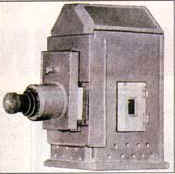
Mahadeorao Gopalrao
Patwardhan

Vinayak Mahadeorao
Patwardhan

Patwardhan's projector
which he used for -
Shambarik Kharolika
THE PATWARDHANS
It was not that the Indian public had never seen a moving
picture show.
As in Europe and America, magic lantern shows were also popular in
India much before the advent of cinema. Many of the more enterprising
showmen like Madanrao Mahadev Pitale even used several consecutively
placed slides to tell a story. Inspired to go beyond Pitale's experiments in narration,
Mahadeo Gopal Patwardhan procured an old magic lantern and began to experiment with
the art of making slides in 1890. He also involved his son Vinayak, a graduate of the Sir
J.J. School of Arts at Bombay, who became an expert at making slides. However, what
fascinated the father and son duo was Two of the slides used by the Patwardhans not merely
showing a succession of slides, even if it was to tell a story, but to create the form of
a movement so as to bring the story alive.
At last their experiments were successful and two years later,
in 1892, they were ready to hold their first show which was held as a part of a function
to felicitate Justice Kashinath Trimbak Telang on his appointment as vice-chancellor of
Bombay University. The show was dubbed as Shambarik Kharolika, which isthe Marathi
equivalent of magic lantern. The technique used for this primitive animation was quite
novel and yet, very simple. Slides were prepared by painting directly on transparent glass
plates. Two glass plates were used in tandem to create one scene. One glass plate
contained the major elements of the scene which would remain static while the other glass
plate contained the moveable elements. At first one glass plate was projected and then,
the other glass plate was slowly brought into position and even moved backwards and
forwards to create the appearance of movement.
Emboldened by the success of this effort, the Patwardhans began to hold commercial shows of their programme which slowly expanded to almost two- and-a-half hours. By 1894, the proposition was lucrative enough to involve the entire family. Mahadeorao's younger son Ramchandra also joined the venture and Mahadeorao began to think in terms of making the animation more realistic. He began to use three magic lanterns: one to project the static background scenes and the other two to project bits of the action. This made it possible to create even more complex scenes with several bits of simultaneous action.
In spite of all these innovations the basic structure of the
programme was essentially Indian: the stories were taken from mythology though there were
a few adventure stories and even a series involving animals. The show generally began with
the entry of a sutradhar (narrator) and two singers and was then followed by the main
feature. This was the pattern set by the ancient Indian dramatic tradition as outlined in
the natya shastra. Some of the programmes which still survive with the Patwardhan family
(who even now live at Kalyan, on the outskirts of Bombay) are the legend of Krishna's
birth and scenes from the Ramayana.(The show was salvaged due to the efforts of composer
and archivist Bhaskar Chandavarkar who set the show to fresh music and held a few
performances during the centenary celebrations.)
Having perfected his three-lantem version, Mahadeorao went on an extended tour of the
entire Bombay Presidency (now the states of Maharashtra and Gujarat) during 1894- 95.
Their tour terminated on December 27, 1895 — ironically exactly a day prior to
Lumiere's first public show at the Salon Indien in Paris — at Poona where the
eleventh Indian National Congress was being held. A show of the Shambarik Kharolika was
held in the presence of such dignitaries as Lokmanya Tilak, Surendranath Bannerji and many
others.
Shows came to a standstill with the onset of the plague and could not be revived till the
arrival of the new century. In the meantime Mahadeorao passed away in 1902.

Two of the slides used by the Patwardhans.
Home
The Arrival of Cinema
The Trio
Sawe Dada